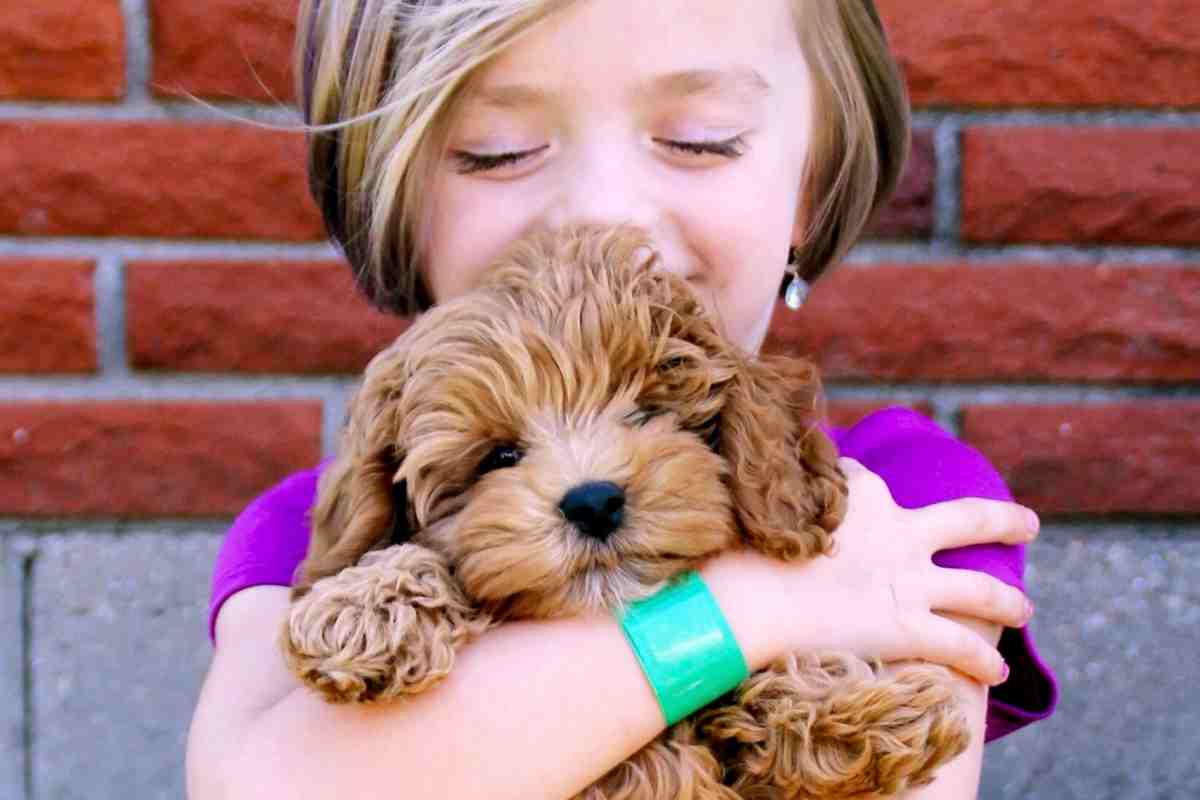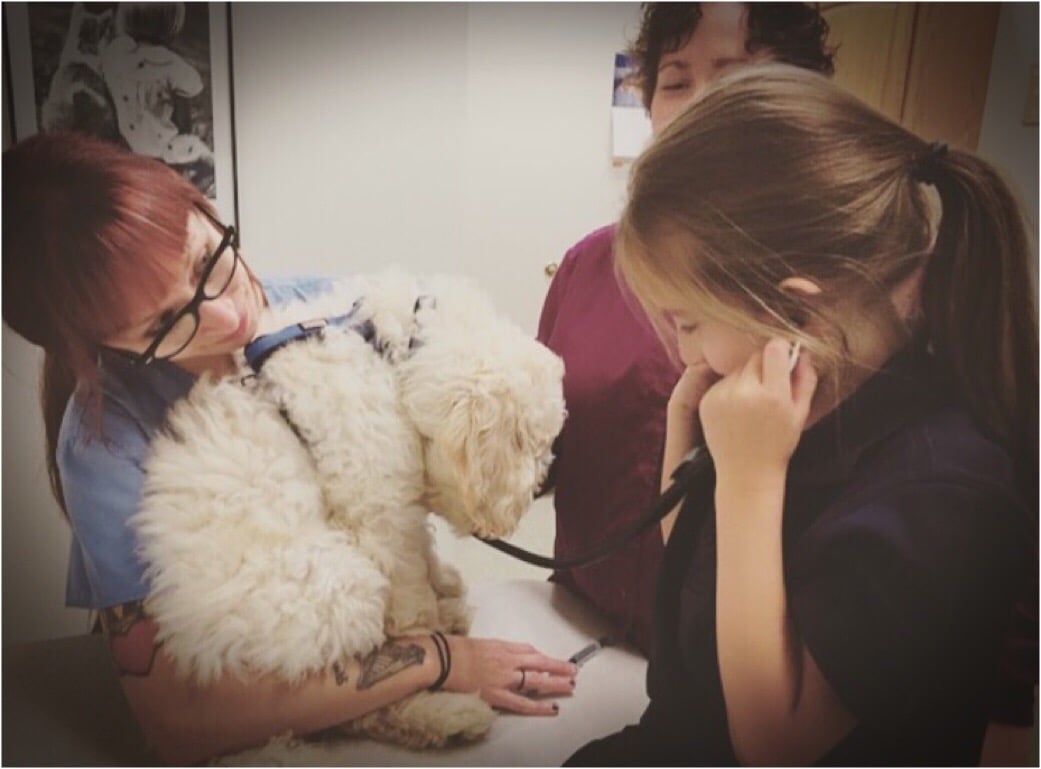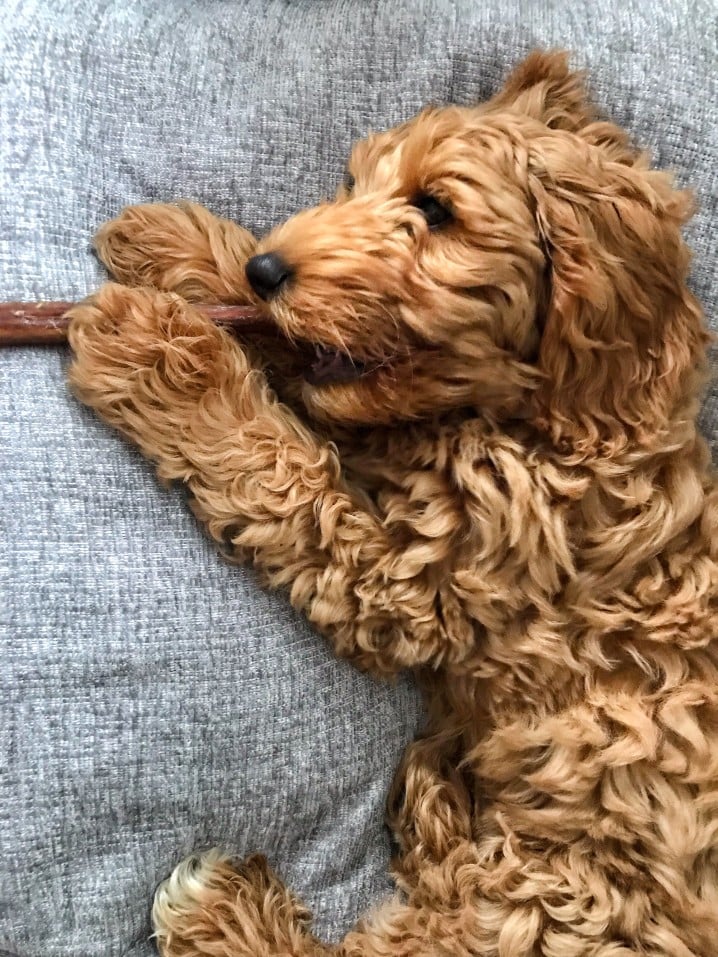How To Take Care Of A Goldendoodle Puppy: 14 Veterinarian Tips
How to take care of a Goldendoodle puppy: A Veterinarian’s advice for first-time Goldendoodle owner’s guide
Have you just gotten your first Goldendoodle puppy? They are known for their excellent temperaments and for being great for people with allergies. They make great guide dogs, service dogs, therapy dogs, or just plain old family pets. But there are many things that you need to do to make sure that your puppy is happy and healthy.
This article is a complete Goldendoodle Care guide for puppies.

There are many things that you need to do to make sure that your puppy is healthy and
happy.
- Vet visits for vaccines and spay or neuter
- Provide a high-quality diet
- Potty training and Socialization
- Behavioral Training
- Monitor for signs of Illness
By following these steps, you will have your Goldendoodle puppy started on the right track for a long healthy, and happy life.
This Golden Doodle Care guide will provide you with the needed resources when you have a question on how to raise your Goldendoodle puppy.
1 – Regular Vet Visits
When you get your Goldendoodle (a crossbreed between a Poodle and a Golden Retriever that has recently increased in popularity), you will want to schedule an appointment for them at your veterinary office. While this hybrid dog breed is not prone to health issues, they can still contract issues like ear infections or other issues from their environment.
Your vet will examine your puppy to make sure that they are healthy and review what vaccines they may have previously received.
Most of the time, they will check their stool for worms and get them started on a vaccine schedule. This is a common schedule that most vets follow for vaccines.
2 – Vaccinations
- At 6 weeks: your Goldendoodle will receive a Distemper/Parvo/Parainfluenza vaccine and a Kennel Cough vaccine. This is usually done by the breeder before you get your Goldendoodle puppy.
- At 9 weeks: your Goldendoodle will receive a booster of their Distemper/Parvo/Parainfluenza vaccine and a Kennel Cough vaccine.
- At 12 weeks: your Goldendoodle will receive a Distemper/Parvo/Parainfluenza vaccine, a Leptospirosis vaccine, and a Canine Influenza vaccine
- At 15 to 16 weeks: your Goldendoodle will receive a Distemper/Parvo/Parainfluenza vaccine, a Leptospirosis vaccine, a Canine Influenza vaccine, and their Rabies vaccine
During these appointments, your vet may also check a fecal sample to look for worms in your Goldendoodle’s poop. Most of these worms are microscopic, but some you can see in their stool.
If you see worms, make sure to let your vet know. Your vet can give your Goldendoodle puppy medication to get rid of these nasty worms.
Not only will your pet need vaccines, but they will also need heartworm, flea, and tick prevention. All of these parasites can cause health problems in your Goldendoodle, some of which can be fatal.
3 – Spaying and Neutering
Most vets recommend spaying or neutering your Goldendoodle puppy around 6 months of age.
Some people will wait a little longer before spaying and neutering to allow their Goldendoodle with you. Your veterinarian can discuss the pros and cons of spaying your dog around 6-month vs. waiting.
The American Veterinary Medical Association (AVMA) recommended spaying and neutering before your Goldendoodle’s first heat cycle. This decreases the chance of mammary tumors in females and eliminates testicular cancer in males.
By not spaying your dog, you are risking them developing a pyometra. A pyometra is an infection in the uterus that can be fatal if not caught early enough.
Puppies recover from the spay or neuter procedure very quickly, where older dogs may take a few days. Surgery on your young puppy will help them from developing major problems later on in life.
While puppies can be very cute, over breeding dogs has caused lots of pets to end up in a shelter and not in a loving home.

4 – Providing A High-Quality Dog Food
A good quality dog food is key for taking care of a Goldendoodle. For your dog to stay healthy, they will need proper nutrition.
Not all dog food contains the needed protein and fats that are needed in your Goldendoodle puppy’s diet.
There are many great diets on the market. Most pups will need food that is higher in protein than adult food. When looking for a diet, you should look for one that has at least 22% protein.
You should also look at the ingredient list on the back. The first ingredient should be protein. It is also better if it is the whole protein and not a protein meal.
Once your Goldendoodle puppy is almost fully grown, you can switch to adult food. This is usually 8 months to 1 year of age.
Most Goldendoodles will stay on an adult diet until they are around 7 years, then they will switch to a senior diet.
Your veterinarian can recommend many great brands of dog food. And don’t forget about treats as rewards throughout the day. Treats often contain higher amounts of fat than regular dog food.
5 – Feeding Them The Right Amount
Most recommended following the feeding instructions on the bag, but a good rule of thumb is about 1 cup per 15 pounds a day. Most of the time, it is recommended to split these feeding into a few different feedings each day.
When your puppy is very young, most vets worry about your Goldendoodle puppy being able to regulate their blood sugar. By giving them multiple meals a day will help keep their blood sugar at optimal levels.
Some people will feed their puppy a mixture of wet food and dry food as their teeth are coming in, and once they have all of their teeth with switch them to strictly dry food.
When feeding your Goldendoodle wet food, make sure to decrease the amount of dry food that you are feeding them, or your Goldendoodle can become overweight.
6 – Behavioral Training
When you first get your Goldendoodle puppy, you will need to train them on how to act and socialize them with other people and pets.
This makes sure that you raise a well-mannered Goldendoodle. You will have to train them on how to do many things such as:
- Potty Training
- Not to bark
- Not to Chew on things
- Simple sit and stay commands
- How to walk on a leash
7 – Potty Training
There are two main ways that people potty train their dogs. Most people will crate train or potty pad train their Goldendoodle puppies.
Crate training is the most common way, but people in apartments or people who live where winter is very harsh sometimes prefer potty pad training as they do not have to always take their dog outside.
8 – Crate Training
Some people do not want to keep their Goldendoodle in a crate all day while they are gone. Usually, after a few days, these puppies will adapt to being in a crate during the day.
It will even make life easier for you, especially if they are making a mess all over the house or destroying everything in the house.
By using consistency and teaching your dog that staying in a crate is fun and not scary will not only make potty training easier, it will also help with vet visits and traveling.
Goldendoodles love having a place to call their own. By providing them with a crate, full of blankets and toys, and their food bowl, they will quickly love spending time in their crate. By making this space fun and cozy will make it very easy to train your Goldendoodle to stay in a crate and reduce the likelihood of separation anxiety.

How to Crate Train Your Puppy
When you use a crate to house train your Goldendoodle, you are using the principle that Goldendoodle’s love to be clean. They do not like lying next to or in their urine or poop.
If your dog’s crate is just big enough for them to stand up, turn around, and lay down, then they will not be able to use the bathroom in one corner and sleep cleanly and comfortably in the other.
If you have a large mixed breed Goldendoodle puppy (probably from a Standard Poodle parent), you can still get a big crate and use the partition provided with the crate to block off a section of the crate for them to stay in while they are growing.
When you are not able to watch your puppy constantly put them in their crate. Many times, this will be when your puppy wants to sleep, or you are gone from the house.
Your new puppy will let you know that they need out to potty. These signals may be whining and scratching at the side of the crate or barking at you.
As soon as you notice these signs, take your puppy out immediately. Do not let them use the bathroom in their crate as this teaches them it is okay to potty in their crate.
Eventually, your puppy will be able to hold it the whole time in their crate without having an accident.
9 – Pad or Paper Training
If you do want to allow your Goldendoodle to have a place to potty inside, the potty pad training them is a great idea.
Potty pad training is great for people who are at work for a very long time or people who cannot make it home during the day to let their Goldendoodle outside.
This is also great for small Goldendoodles that live in an apartment or in an area where winter is very harsh.
By potty pad training your Goldendoodle puppy, you are giving them an approved location to use the bathroom while you are gone.
Sometimes potty pad or paper training your puppy is not the best thing to teach them to do. If your final goal is to only have your dog use the bathroom outside, then it is advised to skip potty pad.
Potty pad training can teach your dog bad habits and that it is okay to use the bathroom inside the house. Many times, this can be very confusing for young Goldendoodle puppies.
10 – Potty Training
Potty training is very simple. There are both disposable potty pads and washable potty pads that you can reuse. Lay one of these pads out for your puppy.
When you would take your Goldendoodle puppy outside to use the bathroom, take them to the potty pad instead. Your Goldendoodle puppy will quickly learn that this is an approved place for them to use the bathroom.
When you first start to potty train your Goldendoodle, there will be many frustrating times.
With a little persistence and patience, your Goldendoodle puppy with quickly learn where is an approved spot for them to use the bathroom.
Goldendoodles are very smart, and very quick learners most only have a few accidents in the house. Some do take a little longer to potty train usually because they can also be very stubborn.
11 – Chewing
All puppies will go through a teething phase where they will chew on anything. This is a normal and sometimes painful process.
Your Goldendoodle puppy will start to lose teeth around 3 months of age and continue until they are a little over 6 months.
During this time, you will notice that your Goldendoodle puppy is chewing on anything and everything. This behavior can become a lifelong habit if you do not give your dog something approved to chew on during this puppy teething phase.
During the teething phase, your Goldendoodle puppy will find many different types of objects to chew on to relieve the pain from the new teeth coming in.
Teething is a very important part of your Goldendoodle’s development. But chewing on your furniture and shoes is usually not a wanted behavior.
You should give your dog appropriate toys and teething devices during this time. Also, you need to teach your Goldendoodle puppy that nipping and biting people and other animals are not allowed.
If you have another pet in the house during the time that your Goldendoodle puppy is teething, monitor their playtime as sometimes these nips and bites can escalate into a serious fight.

12 – Socializing Your Goldendoodle Puppy
It is best to start to socialize your puppy early. This is one of the most important parts of caring for your Goldendoodle. Goldendoodles are a very energetic dog, so give them a chance to get in some exercise!
Socialization should start around 8 weeks old. Most people will start with puppy classes. This is a way that you can get your Goldendoodle puppy around other puppies.
During your Goldendoodle puppy first few months of life, you need to introduce them to many different sounds and environments.
Puppy classes will give your puppy the opportunity to learn basic commands such as sit and stay as well as how to walk on a leash.
During this time, it is recommended that your Goldendoodle experiences different types of social environments involving people and other dogs.
Without this proper Socialization and training, your Goldendoodle puppy may be afraid in certain situations, such as with new people or animals. When training your Goldendoodle puppy, think of all situations that they may have to encounter in their life.
Your Goldendoodle puppy should be relaxed around new people, pets, cars, people on bicycles, honking horns, stairs, cats, exams by the vet, and large crowds of people.
If you can get your dog to get used to these situations will make for a much more relaxed life for you and your Goldendoodle.
Between 2 and 4 months of age, your puppy is the most comfortable learning these new behaviors, having new experiences, and meeting new people or animals.
They may still be scared at first, but you can help them by taking them very often to new places and around new people. Also, provide positive reinforcement when they behave appropriately and support them if they are afraid.
After your Goldendoodle is 4 months old, they are usually less tolerant of learning to adapt to new environments and people or animals. This can make obedience training difficult in an older dog.
13 – Grooming Training
Your Goldendoodle puppy will not need much grooming for the first few months. Just a good brushing every day or so to prevent mats and remove tangles will suffice.
However, your Goldendoodle has a life of grooming ahead of them, so it’s important to get them used to your grooming routine from an early stage to prevent problem behaviors later and instill good behavior that is conducive to grooming.
Show them all the tools, including your clipper,
This will make grooming them as adults much easier in the future (your groomer will thank you!).
14 – Signs of Illness in Your Goldendoodle
When your puppy is young, they are susceptible to many diseases and illnesses.
Some of these can be very serious and many times are 100 % preventable. This is why you need to make sure that your Goldendoodle receives all their needed vaccines.
These vaccines alone will not prevent all disease. You will also need to watch your puppy for any signs of Illness. If you see any of these signs, you need to take your Goldendoodle puppy to your vet as soon as possible.
- Not eating
- Nota gaining weight
- Vomiting
- Swollen and painful
stomach - Lethargic
- Diarrhea, especially
if there is blood in there - Trouble breathing
- Coughing
- White gums
- Red, swollen eyes,
with or without discharge. - Discharge from the
nose - Not able to pee or
poop
Many of these signs can mean that there is something seriously wrong and need vet attention soon.
If you see any of these signs or symptoms, contact your veterinarian. They can advise you on what to do next and if it is best that your dog is seen by them.
Final Thoughts
Goldendoodles can be fun-loving pets, but there are certain things that you need to do to make sure that they are started off on the right foot as far as keeping them healthy.
As soon as you get your new Goldendoodle puppy, it is best to have your vet check them over and review their vaccine history.
This way, you can get started right away with the necessary prevention to keep your pets healthy and happy.